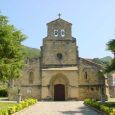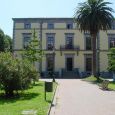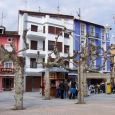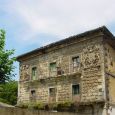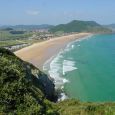Santona
Advertisement
By air
Nearest airports to Santona are sorted by the distance to the airport from the city centre.
Santander Airport (distanced approximately 29 km)
Bilbao Airport (distanced approximately 47 km)
Vitoria Airport (distanced approximately 86 km)
Burgos Airport (distanced approximately 120 km)
Ila Da Chilonzuene Airport (distanced approximately 130 km)
Church of Santa Maria del Puerto
The church of Santa Maria del Puerto located in the town of Santona is a temple of the Romanesque style of the first half of XIII century. It was declared a National Monument on June 3, 1931. This temple was part of a monastery of Benedictines, probably built in the eighth century, in time repopulate the area.Its origin is legendary. It is said that the church was founded by James the Apostle, when he was in Spain in 37, with the rank of cathedral and consecrated Arcadio as bishop. Then in the eighth century is when he founded the Benedictine monastery in the same place.
Chiloeches Palace
Chiloeches Palace or Old Military Hospital in the town of Santona, in Cantabria. Built by Antonio Ortiz de Santelices, Marquess of Chiloeches in the early eighteenth century. In this palace, his son was born Ramon Ortiz Otanez, Lieutenant General of the Royal Navy. The building had various uses over time, in the mid- nineteenth century was the seat of the Military Hospital until the Spanish Civil War that was fitted as a prison. In 1972 he was declared of cultural interest. It is now privately owned and is in ruins.
Palacio del Marques de Manzanedo
Manzanedo Palace is located in the town of Santona in the Cantabria. It was built in 1864 Juan Manuel de Manzanedo and Gonzalez de la Teja, Marquis and Duke of Santona Manzanedo. The architect and director of the works was Antonio Ruiz de Salces. Style neoclassical and almost square, consists of two buildings and garages. It has 2 floors and attic. It is built in masonry plastered and stalls in the basement corners and openings. The facades are presented with large windows and a balcony on the second floor. The entrance gate is arch. In recent years the building has been renovated and now houses the tourist office and exhibition halls.
Plaza de San Antonio
The Plaza de San Antonio is located in the heart of the town of Santona. It is also the social center. It is a large square, lined with benches, a kiosk of music located on the east, is surrounded by homes, businesses, cafes and banks.
Berria beach
The beach is Berria located in the town of Santona. It is a beach located on the isthmus connecting the peninsula that forms the mountain Buciero with the municipality of Argonos. The 2,200 meters in length are developed between Mount Brusco, west, and east Buciero massif. The sand is white and thin, has a gentle slope and is awarded the Blue Flag. It opens to the sea on the north, the south are the Santona Marshes.
Monument to Juan de la Cosa
Erected in memory of Juan de la Cosa, a native of Santona, navigator and cartographer of the fifteenth century, known for having designed the first world map showing the lands discovered in America in the fifteenth century. It is located on the promenade, known as the Passage. It was built in 1949 by architect Hernandez Morales. It consists of two large Doric columns columns symbolizing the Hercules and where you can see the emblems of the Catholic Monarchs. On the columns stands a caravel, the Santa Maria, whose owner was Juan de la Cosa.
Monument to Luis Carrero Blanco
This monument erected commanded the City of Santona in 1976. It is dedicated to Luis Carrero Blanco, who was born in Santona in 1904, was president of the Spanish Government on the Franco regime and was killed as a result of a terrorist attack in 1973 by ETA in the city of Madrid. The sculptor was Juan de Avalos.
Information not available


